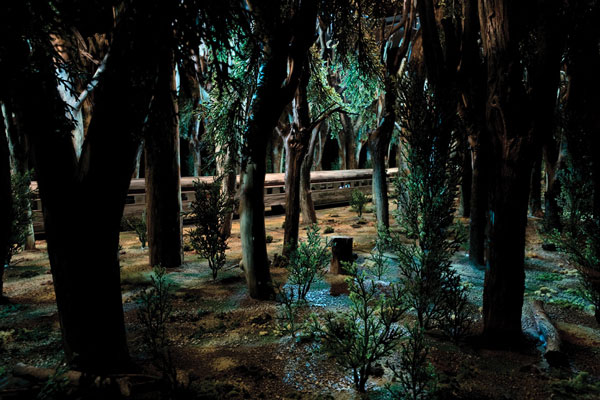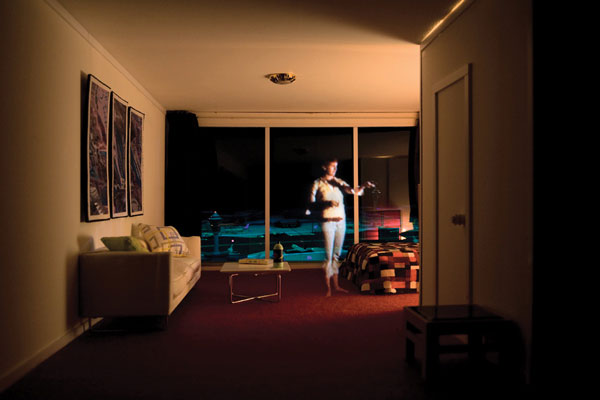[Summer 2010]
by Petra Halkes
David Hoffos
Scenes from the House Dream
National Gallery of Canada, Ottawa
November 6, 2009 to February 14, 2010
Despite the impending calamities hidden in many of the works in Scenes from the House Dream, David Hoffos’s gathering of twenty installations into one, dark, enveloping space feels warm and fuzzy. True, a monster lurks under a boat, vapours rise in a noisy forest, and snow drifts through the open windows of a deserted house, but the exhibition curated by Shirley Madill remains appealing and enchanting.1 Visiting children eagerly step on stools to peer through small windows in the wall that open onto magical worlds in which tiny ghostly figures appear and disappear, teasing their imaginations and arousing a titillating fear and pleasure. Older folks, like this jaded art critic, are transported to a childhood-time before art, a time of puppet shows and magicians, of making shoebox dioramas and clay gnomes, and reading fairy tales in which secret doors, hollow trees, and wardrobes lead into strange worlds that seem as real as the one that was left behind.
How difficult it is, through a lifetime, to keep recouping that sense of wonder and awe for human-made things that brings us to art in the first place. Hoffos’s exhibition manages not only to do this, but also to create a scope for grown-ups to consider such enigmas as why we seem to need illusions as consolations for our reality, and what it means to be a person rather than a puppet.
The soothing, immersive atmosphere that Hoffos creates for his work sets it apart from Tony Oursler’s disturbing spectacles and Wyn Geleynse’s discreet constructions, though these artists too, project moving characters onto constructed models. The total enclosure of Scenes from the House Dream allows for a withdrawal from the real world into a womb-like dream space in which time dissolves and unremembered feelings of a prelapsarian wholeness begin to emerge.
Hoffos counters this regressive mood by leaving plenty of clues about how this dream-state is created. Our path is littered with TVs that show the moving images reflected in the dioramas behind the windows. He even allows for a look behind the scenes: through a hole in the wall we peek into a storage space, only to see this reality muddled by a not-so-real cat, snoozing among the boxes. The last installation, Hall Room (2008), presents the exit from the dream. We look at the sheet-covered props from the scenes we have just seen. They are placed in a hall of mirrors that reflect rows of columns to infinity; the desire to suspend our disbelief in the wondrous, and to connect to something beyond ourselves, is as endless as this mirrored room.
It is a longing that runs freely through popular culture – through the panoramas, dioramas, and phantasmagoria of the nineteenth century, and the Imax and sci-fi movies of the twentieth, all of which resonate in Hoffos’s work. In this tradition, we viewers have no control over what we see; its interactivity resides solely in imagining an otherworldly power that helps us forget ourselves. In one installation, Petite Princess (2008), the viewer finds herself at the end of the puppet master’s invisible strings: caught by a spy camera, she becomes one of the illusory characters, moving about behind a window of an otherwise deserted house.
To be connected to the larger authorial power of a puppeteer answers a desire for transcendental connections, but foils the opposing will to cut the strings and write one’s own stories. Hoffos recognizes the roles that contradictory desires for connectedness and self-sufficiency play in becoming a person. By letting the viewers in on his conspiracy of illusions, he plays these desires out against each other, and presents an illusionary fulfilment of both.
The puppeteer and his strings are nowhere to be found, but the other-worldly atmosphere of the darkened, placeless space facilitates consoling dreams of his presence. The small characters behind the windows and the three life-sized figures that mingle with the viewers in front of them present an independence that is just as illusionary: they are nothing but ephemeral forms, colour, and sound, disconnected from the real bodies that they represent.
Hoffos, the absent puppet-master, searches to repair connectivity by relying on technology, even though technology helped us cut the strings in the first place. To this end, he ignores the computer – with its built-in commands that usurp our freedom – but uses dated techniques of mirrors, lenses, and video projections, which he can set to his sleight of hand, and which can (almost) be comprehended by his viewers.
C.P. Fail (2008) shows a train halted in the middle of a forest. A train, with its sleek self-contained compartments, its speed and linear forward movement, is the epitome of technological progress, but here it is stopped in its tracks. The train is not abandoned; we can see people inside, moving toward each other, seeking contact, sitting down. Embedded in this wonder of technology, these people create a temporary home by making human connections – the only ones they know that can be made real.
1 David Hoffos: Scenes from the House Dream was organized by the Rodman Hall Art Centre (RHAC) at Brock University in St. Catherines, in partnership with the Southern Alberta Art Gallery, Lethbridge, and Trépanier Baer Gallery, Calgary. The National Gallery is the second venue on a tour that continues to the Art Gallery of Nova Scotia in Halifax and the Museum of Contemporary Canadian Art in Toronto. In 2011, the Illingsworth Kerr Gallery at the Alberta College of Art in Calgary will be the tour’s final stop.
Petra Halkes is an artist and writer living in Ottawa.


